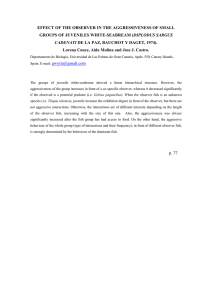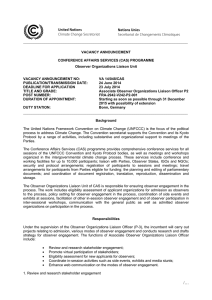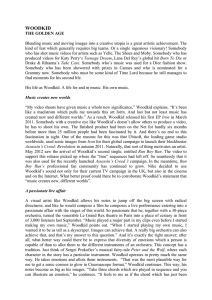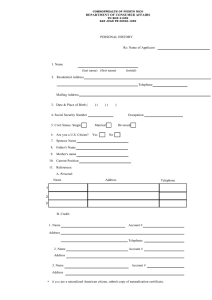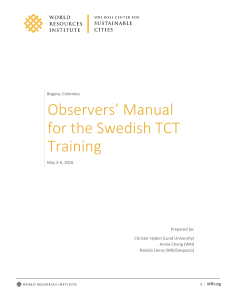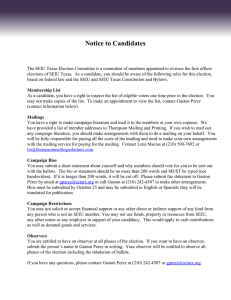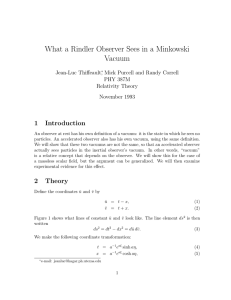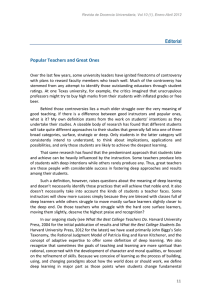Practice-Teaching-A-Reflective-Approach-Chap-7-Classroom-Observation-in-Teaching-Practice unlocked
Anuncio
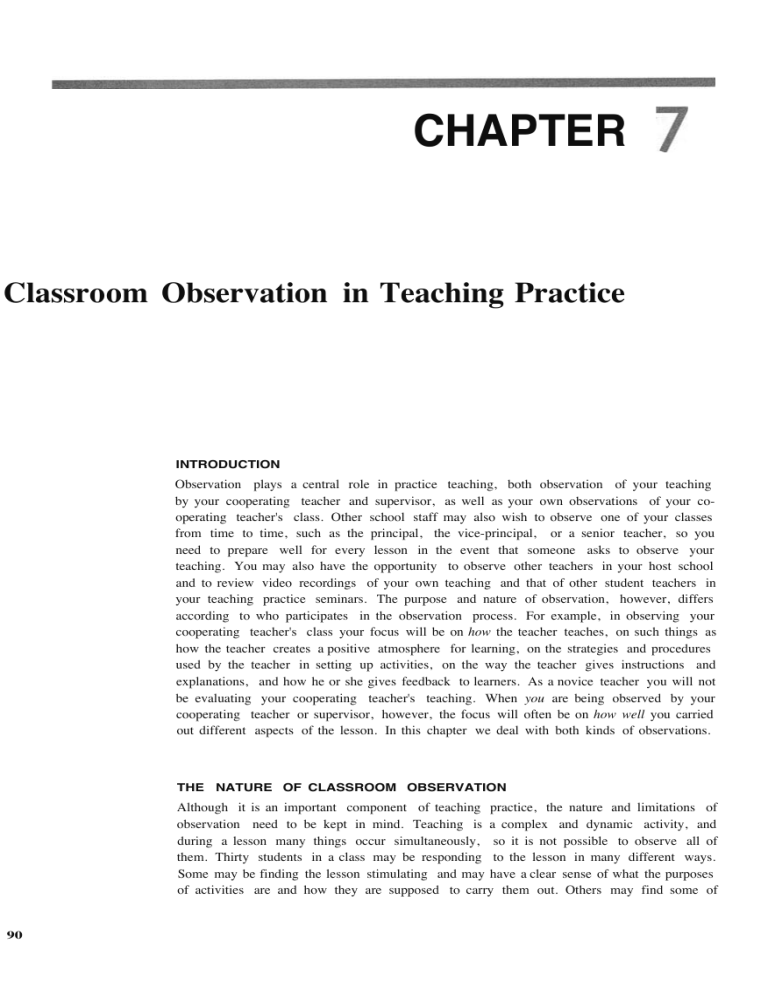
CHAPTER Classroom Observation in Teaching Practice INTRODUCTION Observation plays a central role in practice teaching, both observation of your teaching by your cooperating teacher and supervisor, as well as your own observations of your cooperating teacher's class. Other school staff may also wish to observe one of your classes from time to time, such as the principal, the vice-principal, or a senior teacher, so you need to prepare well for every lesson in the event that someone asks to observe your teaching. You may also have the opportunity to observe other teachers in your host school and to review video recordings of your own teaching and that of other student teachers in your teaching practice seminars. The purpose and nature of observation, however, differs according to who participates in the observation process. For example, in observing your cooperating teacher's class your focus will be on how the teacher teaches, on such things as how the teacher creates a positive atmosphere for learning, on the strategies and procedures used by the teacher in setting up activities, on the way the teacher gives instructions and explanations, and how he or she gives feedback to learners. As a novice teacher you will not be evaluating your cooperating teacher's teaching. When you are being observed by your cooperating teacher or supervisor, however, the focus will often be on how well you carried out different aspects of the lesson. In this chapter we deal with both kinds of observations. THE NATURE OF CLASSROOM OBSERVATION Although it is an important component of teaching practice, the nature and limitations of observation need to be kept in mind. Teaching is a complex and dynamic activity, and during a lesson many things occur simultaneously, so it is not possible to observe all of them. Thirty students in a class may be responding to the lesson in many different ways. Some may be finding the lesson stimulating and may have a clear sense of what the purposes of activities are and how they are supposed to carry them out. Others may find some of 90 Classroom Observation in Teaching Practice the activities insufficiently challenging or motivating and may be paying minimal attention to the teacher or the lesson. And at the same time the teacher may be struggling mentally to maintain the flow of the lesson and may have realized that he or she set the lesson up in a nonproductive way. None of these aspects of the lesson are directly observable. And even if aspects of classroom behavior are observable - such as the amount of talking students engage in when completing an activity - you may not be able to tell whether this is an indication of confusion or of interest. For all these reasons information you or your cooperating teacher gain during an observation always needs to be clarified through conversation and discussion in order to understand the meaning of what you observed (or thought you observed). At the same time, the presence of an observer in the classroom sometimes influences the nature of the lesson, making the lesson untypical of the teacher's usual style of teaching. As a student teacher you may "overprepare" for a visit by your supervisor or cooperating teacher in order to show yourself at your best. You may also feel tense knowing that the observer is not only there to assist you in developing your teaching skills, but also to evaluate how well you are doing. However, initially you may find the presence of your cooperating teacher or supervisor distracts you from being able to teach your best. If this is so you should discuss this with the observer both before and after an observation. Experienced teacher trainers are of course well aware of the influence their presence may have on a student teacher, but comments such as the following are not uncommon: [was so scared the first time [was observed by my cooperating teacher because [ knew she was evaluating me as a teacher. Sometimes [ looked in her direction and saw her writing something down and [ wondered what she was thinking and at those times [lost a bit of my own flow of teaching. Anyway, [was glad when it was over and only wanted to know what she thought of my teaching. Jae Hee, Korea [ could never be myself when [was being observed by my cooperating teacher, no matter how much she tried to put me at ease before the observation or how much [ had prepared before the class. [ could not sleep properly the night before each observation. Even my students could see that [ was not normal when someone (either my supervisor or my cooperating teacher) was in the back of the room and they always asked me how [ was after class, which was sweet. Catharine, United States The first time my supervisor just showed up and [froze, literally. He would pick a morning that was after the night before for me because [was still a university student and thus active on campus as [ returned each day after teaching practice. [was not fully prepared for the class and [ guess it showed because [think the students couldfeel this too. Needless to say, [ was always well prepared after this and [ realized that this was a real job and settled down to teaching practice after this. John, Canada Last term, [ observed three different teachers teaching different classes and different skills. [ realized that a teacher's personality has a lot to do with the functioning of a class. This term, [ began my practice teaching by observing my cooperating teacher teach the first two classes. [ realized that the more experienced a teacher is, the more effortless a class appears to move. After two classes of observation, it was now my turn to be observed. [found it to be a very uncomfortable experience. [felt (and still feel) that [was not myself when [was being observed. [ continuously felt the pressure of being observed by the teacher on one 91 I r 92 Practice Teaching: A Reflective Approach end and the students on the other. In trying to be acceptable to both, I seemed to lose all focus on the learning demands of the students. Vidya, Canada OBSERVING YOUR COOPERATING TEACHER'S CLASS Your practice-teaching assignment will often begin with a series of observations of your cooperating teacher's class. These observations will give you a chance to familiarize yourself with such things as the course materials the teacher is using, the teaching methods and strategies the teacher uses, how he or she interacts with students, how the learners respond and interact with the teacher and among themselves, and the kinds of language they understand and produce. These observations will help you prepare yourself for some of issues and problems that you may have to face while teaching the class. You can see what methods and strategies the teacher employs and decide if you will be able to use these yourself when you come to teach the class. You will also learn more about the learners (e.g., their interests, motivations, and learning styles) and this will better prepare you for the time when you will take over teaching the class. As Gaies (1991) has pointed out, "What we see, when we observe teachers and learners in action, is not the mechanical application of methods and techniques, but rather a reflection of how teachers have interpreted these things" (p. 14). THE Focus OF THE OBSERVATION If observation is to serve a useful purpose it needs to be carefully planned. The purpose of the observation is to collect information that you can later use during a follow-up discussion with the teacher. Before you observe your cooperating teacher's class you will normally have a preobservation meeting to decide on the focus for your observation and the procedures you will use to record your observations. You may suggest aspects of the class you would like to learn more about, such as how the teacher makes use of group work or how he or she deals with classroom management. Your cooperating teacher will also suggest things to look for during an observation. Normally you should focus on only one or two aspects of the lesson since you cannot focus on too many things at the same time. Some aspects of a lesson are relatively easy to observe (such as the kinds of questions students ask), whereas others may not be observable and have to be inferred (such as the degree of interest students had in the topic of the lesson, decisions teachers made during a lesson, or problems that occurred that might not have been visible to an observer). The following are examples of the things your cooperating teacher might ask you to observe during his or her lessons: Lesson • • • structure The way the lesson opens, develops, and closes The number of activities that constitute the lesson The links and transitions between activities Classroom management strategies • Setting up groups • Maintaining order • Time management • Seating arrangements Classroom Observation in Teaching Practice Types • • • of teaching activities Whole-class activities Pair and group activities Individual activities Teaching strategies • Presenting tasks • Organizing practice • Teaching techniques Teacher's use of materials • Use of the textbook • Use of other resources Teacher's use of language • Use of instructional language • Use of questions • Feedback techniques • Explanations of vocabulary and grammar Students' use oflanguage • Use oflanguage in group work • Use of the mother tongue during class • Problems with grammar • Problems with pronunciation Student interaction • Time on task • Questioning behaviors • Student-to-student talk The following comments illustrate what different student teachers learned from being observed: When I started to observe my cooperating teacher she just said to watch the class in general and how she started the class and went through the various activities she had planned I had a copy of her lesson plan. Then after the class she told me what she thought of it and how it went from her perspective. She said that she was happy that all her students were participating and learning. What really struck me was how she was able to get all her students involved. I was surprised because this was a big class of 30 students and it was fast moving, so I wondered how she took it all in. For the following observations she asked me to focus on classroom management and how she accomplished this because she told me I would have to take over this class and she had wanted me to know how to control them. I found observing my cooperating teacher very useful because I incorporated many of her classroom management techniques when I took over the class and they worked because the students were used to them. Jin Da, Thailand After observing my cooperating teacher's class I realized that giving clear, precise, and brief instructions to the class is an important skill as it avoids miscommunication and misunderstanding between the teacher and students in class. In giving out long instructions, I realized I could help the class by writing the instructions down so that time can be used more productively. This would enable the class to clarify any doubts they have and also to ensure that the class is clear on the requirements of the assigned task. Bernie, Singapore 91 1 r 94 Practice Teaching: A Reflective Approach My cooperating teacher gives me very little feedback about my teaching. So I feel that I don't get to learn much from her. So the fact of being observed just plays as a negative factor rather than anything constructive. But I also realize that half of the problem is my own dOIng. I have been focusing on the wrong issues. Rather than try and evaluate the needs of the students, I have been trying to be acceptable to the others. I now try to concentrate on the lesson plan and the course material and try to forget that I am being observed (though I am not always successful in this). Vidya, Canada OBSERVATION PROCEDURES In order to make effective use of observation, you will have to decide how to make a record of the information you collect. The procedures you use will depend on the focus of the observation, but the following are often used. • Checklists A checklist contains a list of different features of a lesson, which you complete while observing a lesson. Checklists provide a clear focus for observation, however they can only be used for certain aspects of a lesson, such as features that are easy to count, and should focus on only one or two aspects of the lesson. There are several published checklists than can be used in classroom observations (e.g., Wajnryb 1992) but these may need to be adapted to suit your needs. Alternatively, you and your cooperating teacher can develop your own checklists. Examples of checklists are given in Appendix A. • Seating charts Seating charts showing the arrangement of desks in the classroom as well as the position the teacher normally teaches from, can also be used to code such things as the number of times students ask the teacher a question or vice versa, and the number of times a student asks other students questions. The seating chart observation record (SCORE) in Figure 7.1 shows a ten-minute segment of a question-and-answer period after a student (speaker) had delivered a thirtyminute speech in English (Farrell 2008d). The teacher (MH) said that she was surprised to find out from this SCORE analysis that she had asked forty-five questions in the ten-minute period as she had thought that she was "a silent participant as a listener in my classes." She continued, "Until now I had no realization about my questioning pattern." .. IF(s)IS"q IM(s)Wq Note: F(s)=female student; M(s)=male student; MH=Mee-Hee (the teacher); "q=ask; a=answer question. The long arrows show the directional flow of the questions. Figure 7.1 SCORE Analysis I (Farrell 2008d) Classroom Observation in Teaching Practice • Field notes These consist of brief descriptions in note form of key events that occurred throughout the lesson. They can provide a summary of the lesson as a whole, or can be time-based (e.g., every five minutes). For example: 8:30 - Class begins. 8:33 - Teacher writes instructions for class on board as students turn on computers. 8: 35 - Teacher gives oral instructions for online reading task. 8:40 - Students engage in online reading task with computers. 8:45 - Silence - reading comprehension ensues. 8: 50 - Silence 8:55 - Teacher checks with a student about why he's not reading and circulates to see how other students are doing. 9:00 - Silence continues as students read. 9:04 - Students finished with online reading task look up at teacher. 9:05 - Teacher takes up answers for the online reading task students were working on. 9:08 - Teacher tells students to go back to computers to do scanning practice. 9:09 - Teacher assists one student to get online and understand scanning. 9:13 - Teacher helps student scan and then tells whole class what they should be doing when "scanning" andfocusing on key words. 9:17 - Teacher circulates room and helps individual students while reading on their computers. 9:20 - Teacher concludes class. • Narrative summary A narrative summary is a written summary of the lesson that tries to capture the main things that happened during the course of it, such as how the lesson opened, the sequence of activities that occurred, how the teacher introduced each activity, and so on. The account should contain as much information as possible but should not contain any evaluation of the lesson. Here is an example: The teacher initiated the peer-response session of the writing cycle and started the class by asking the students to move into groups to answer questions on peer-response handouts. The students were asked to fill out these handouts to answer questions about their peer's composition. The students sat in groups of four, read compositions and then wrote at length on the handouts. Next they exchanged the peer-response handouts and talked to each other mostly in Mandarin for the remainder of the class. The class ended and all left the room. Tom, Singapore • The follow-up conversation Following an observation, your cooperating teacher will normally find time to discuss your observations with you and to answer any questions you may have. It is important to remember that during the follow-up meeting you should focus 95 1 r 96 Practice Teaching: A Reflective Approach on clarifying and interpreting information you obtained from your observation in order to learn more about how the teacher approaches his or her teaching. For example: o o o Explanations as to why things happened: e.g., "Why do you think the students found this activity difficult?," "Why did you use group work at this point in the lesson?" Explanations of how the teacher would respond to events during the lesson: e.g., "What would you have done, if the students had finished this activity ahead of time?" Suggestions from the teacher: e.g., "How should I respond if students tell me an activity like this is too difficult?" When I observed my cooperating teacher giving instructions to the class I learned that it may not be enough to just tell the students what to do because they may not react until a few minutes later. So when I saw my cooperating teacher also write these instructions on the whiteboard after giving them orally, I noticed afew of the students only seemed to understand at that moment what was required of them. Tony, Brazil I really saw the importance of teacher enthusiasm when I observed my cooperating teacher teaching a class on grammar tenses. Seeing the lesson plan on paper is one thing but she magically transformed that plan into a lively and enjoyable lesson with her bubbly personality. I realized at that time that the teacher is the real method when it comes to teaching, and materials or even plans mean nothing if we don't engage our students. Terry, United States BEING OBSERVED BY YOUR COOPERATING TEACHER OR SUPERVISOR As we noted in Observation Procedures, being regularly observed by your cooperating teacher or supervisor during your practice teaching is one of the things you will doubtless find stressful. Knowing that the strengths and weaknesses of your teaching are being assessed naturally causes some degree of anxiety. However, if you have developed a comfortable working relationship with your cooperating teacher, observation can become a positive learning experience. Your cooperating teacher will usually find many good things to comment on about your teaching. And he or she can also help you monitor your own teaching by observing things that it would be difficult for you yourself to observe. As with observation of your cooperating teacher's class, a preobservation and postobservation conversation is usually scheduled to prepare both you and the observer for your lesson and to discuss it afterwards. There are several purposes for observation by the cooperating teacher or the supervisor: • to collect information about your lesson that it would be difficult for you to observe: e.g., how members of a group interacted during a group task and how much interaction each group member took part in • to observe how you are implementing a new teaching strategy or technique that you are trying out: e.g., how you address reading strategies when teaching a reading lesson Classroom Observation in Teaching Practice • to observe how you implemented specific stages of a lesson: e.g., how you dealt with the opening and closing of the lesson • to identify those aspects of the lesson that were the most successful • to identify those aspects of the lesson that could be improved • to identify techniques and practices you can apply to your own teaching • to help you gain a better understanding of your own teaching In addition to these points, if you are being observed by a supervisor, he or she may be interested in issues such as the following: • to see how you are able to implement strategies and ideas discussed in your training class • to see if you are making progress in your skills as a teacher • to identify issues that can be discussed in follow-up sessions with you and other student teachers Although most research on supervision suggests that the nature of talk between the supervisor and the teacher learner in postobservation conferences is dictated by the supervisor, you nevertheless can take more initiative in these conferences by sharing your reactions to the class, the surprises you encountered, what you would have done differently, what you have learned, and what you think the students have learned. Your supervisor can also help you develop an overall action plan that can help you further develop as a teacher. Your cooperating teacher may use some of the procedures discussed in this section in observing your lessons, or may simply make brief notes to use in a follow-up discussion. However, you may also find it useful to arrange for some of your lessons to be recorded. Audio and video recordings are relatively easy to make (details on procedures for audio and video recording are given in Chapter 11) and provide a more accurate record of a lesson than checklists or observation forms. If you choose this option you may want to transcribe some or all of the lesson if time permits, or simply replay the recording to focus on particular aspects of the lesson. For example, you may be interested in reflecting on the impact of your verbal instructions in a lesson: In this case, you can listen to and transcribe those parts of the tape that show you giving instructions. I never realized that I used the word "OK" so many times when I teach until I heard myself teaching from the audiotape of my class. I am not sure I would have even believed my cooperating teacher if she had told me the same but it was all too real for me when I heard it on tape. I now try to catch myself before I say "OK" and this usually works but when I get excited while explaining something to a student, I still use it a lot. Bob, United States After watching the video of my class I realized that I usually ignore the right side of the room not only with my gaze, which is usually focused on the left of the room, but also with whom I ask questions to as well, which is also to the left side of the room as well. My whole body language looks as if I am facing left and, of course, I cannot then see the students on the right and especially in the front rows. Even the cooperating teacher did not notice this until we watched the class together. Bernie, Singapore 97 1 r 98 Practice Teaching: A Reflective Approach THE ETIQUETTE OF SUPERVISORY OBSERVATION When a teacher learner is being observed for administrative reasons, the observer (this includes the cooperating teacher, the school principal and vice-principal, and the practicum supervisor) should try to make the visit as noninvasive as possible (Master 1983). As Master points out, the observer administrator is a stranger in the room, and in the eyes of a teacher learner a typical observation goes like this: The administrator enters the room, often after the class has begun, and quietly takes a seat in the back row. The teacher may introduce the newcomer but cannot, of course, announce why the newcomer is there (i.e., to see how good the teacher is). Scanning the faces of the students, watching for the cues that indicate the attention level of the class, the teacher is suddenly confronted with a critical, non-participating observer. This establishes a new relationship, no longer between the teacher and the students, but between the teacher and the administrator. The students have become secondary. The lesson plan that once lay clearly in the teacher's mind now evaporates, and the teacher must break rhythm and refer to the written lesson plan on the desk. The students become nervous. The teacher, now so intent on appearing to be a good instructor, loses the ability to pick up the essential facial cues of the students. At the end of the lesson, waiting for the administrator's assessment, the teacher feels nervous, knowing that the class has not gone as well as it usually does. (Master 1983: 498) This "invasive scenario" of classroom observation for administrative purposes can be avoided, as Master suggests, by having the observer follow a certain etiquette in order to bridge the dichotomy between the necessity for observation of teacher learners and this feeling of invasion. Master offers the following guidelines for observation etiquette and his suggestions seem equally relevant today: • Deciding When to Visit: Most teachers prefer that an observer arrive before the class begins rather than at some time during the lesson. This gives teachers the opportunity to establish at least minimal contact and allows them to tell the students that an observer will be visiting the class that day (students are likely to offer spontaneous words of welcome under these circumstances, which can further reduce tension). If the observer can socialize with the students in the immediate vicinity before the lesson, perhaps asking what they have been studying or what they will probably be learning that day, the whole class is likely to feel more comfortable about the observation. There are different opinions regarding whether the visit should be on a pre-announced or a drop-in basis. From the administrative point of view, both have their disadvantages. Pre-announced visits almost always force teachers to put on their best show, giving a somewhat unnatural picture of a normal class period. Drop-in visits run the risk of encountering a quiz or a student report. • Choosing the Best Vantage Point: To avoid the danger of setting up a teacherobserver relationship that excludes the students, the observer should not sit in the back of the room, as is commonly practiced, but rather among the students or facing them from the side in order to have a clear view of the students' faces. Classroom Observation in Teaching Practice • Adopting the Best "Bedside Manner": Some teachers feel more comfortable if they can treat the observer like a student. Others prefer to use the observer as a back-up resource, as the only other native speaker in the room. Still others prefer the observer to be a quiet friendly presence. The observer should be sensitive to the teacher's style, perhaps asking beforehand what the teacher prefers. When the teacher begins the lesson, the observer should appear pleasant and supportive (if the observer feels unable to do this, the visit is best postponed to another day). The eyes of the observer should be not so much on the teacher as on the students, watching how they react to their teacher and how the teacher responds to them. If the students feel themselves to be under scrutiny, they are often stimulated to perform, and this stimulates teachers to behave in a more natural, less threatened manner as they sense the greater response of the students. • Taking Notes: Most observers need to take notes. However, an observer taking notes cannot be a participant in the class at the same time. Hence, an observer who is continuously writing can distract the teacher, just as a student reading a newspaper can. Note taking should therefore be kept to a minimum. A word or a short phrase is usually enough to remember a point found useful or confusing. The observer can embellish the notes later. • Giving the Teacher Oral and Written Feedback: At the end of the lesson, having thanked both teacher and students for the pleasure of visiting the class, the observer should immediately go over the notes taken during the class with the teacher, praising as well as pointing out weaknesses and providing suggestions for improvement. The written report of the observation can take a variety of forms. A desirable format is one in which the observer first describes what the point of the lesson was, then describes the procedures used, and finally comments both specifically and generally on the teacher's handling of the class. This kind of form obliges the observer to be attentive to content as well as to style and enables teachers to challenge the description if they feel the point of the lesson was missed. It also obliges the observer to be a more active participant in the process. This is preferable to the type of observation form in which the observer must simply check appropriate responses like a multiple choice test. Such forms often fail to adequately characterize the unique nature of a single lesson in a single class. Whatever the form used, the teacher should be given a copy and allowed to challenge it, if desired. The teacher should also be given the option of requesting another visit (or another observer when possible) if the class has not gone well, just as the observer, when appropriate, can request a follow-up visit later in the course to see how the teacher has grown with the class and incorporated the suggestions. (Master 1983: 499-500) CONVERSATION WITH THE COOPERATING TEACHER AFTER OBSERVATION OF YOUR LESSON Following an observation of one of your lessons your cooperating teacher will normally want to meet with you as soon as possible after the lesson to discuss his or her observations. Remember, though, that your cooperating teacher may have limited time to discuss your lesson and answer any questions you have, so keep your questions focused. As we saw in Chapter 4, cooperating teachers have different styles of interacting with student teachers, and you and your cooperating teacher will need to establish the kind of supervision style 99 1 r 100 Practice Teaching: A Reflective Approach you both feel comfortable with. The following vignette shows the approach used by one teacher trainer: When talking about their teaching, and particularly when talking about specific lessons they have taught, it is natural for preservice language teachers to focus on their success, or lack of it, in experimenting with the new classroom procedures and techniques they a're exposed to in the methodology part of their teacher education course. In the postlesson conversation with a teacher after observing their lesson, it is important for the teacher educator to acknowledge such experimentation, praise success, and give clear and specific methodological direction when there have been complications. However, as a teacher educator, I am always impressed when a teacher starts the self-evaluation of their lesson not with talk about what they did or didn't do, but rather with comment on the learners and learning; that is, if the pitch of the lesson seemed right, if the aims were achieved, what activities they thought the learners most benefitedfrom, what activities and what particular points of language they thought the learners had trouble with, how learning could have been better promoted. The discussion of specific procedures and techniques can, and indeed should, emerge from discussion of these broader issues. Neil, teacher trainer, Australia Normally the postlesson conversation will follow the following format: 1. You give your account of the lesson, focusing on what worked well, what didn't work so well, and what you might do differently next time. 2. If you have asked your cooperating teacher to focus on specific aspects of the lesson, you can both discuss the information that was collected and its implications. 3. Your cooperating teacher responds to your account of the lesson and adds his or her own observations. 4. Any problem areas of the lesson are discussed and strategies for addressing them are identified. 5. A goal is set for the next observation. The following comments describe a cooperating teacher's postlesson conversation with a student teacher: After the lesson I was a bit nervous to speak to my cooperating teacher because I wondered what she would say about the lesson. I felt the lesson had gone well, but you never know what another more experienced teacher will say about it. To my relief she told me that she was happy with the lesson in general and that it was delivered clearly with a specific direction that was in the lesson plan. She said that she noticed that I attempted to provide more learning opportunities for the students than when she had observed me the previous time and I agreed because the last time, I felt that I had difficulty putting myself in the shoes of learners of that age and of course little did I expect that I had overestimated their learning capacity. I guess this has something to do with my own experience when I was a student - my classmates and I understood what my English teacher was saying most of the time when I was a student. I suppose our better command of English helped. Now I told her that I intend to teach slowly whenever I introduce a new topic in order for students to build a strong foundation for the basics of the topic. I was very pleased that she noticed this change because she had written this on my observation sheet before and now she could see that I was following her suggestions. This time, however, she did suggest that I should try to liven up the lessons a bit as she said I seemed a bit tight. That is true, I guess, but I always feel a bit scared when she observes me and I think I am different and more relaxed when Classroom Observation in Teaching Practice I teach the class by myself. She also suggested that I try to set more of a nonthreatening learning environment for the class, and I should try to inject more humor into the lessons. I think this too is related to my nervousness of being observed by my cooperating teacher. Anyway, I will try to relax in my next observed lesson. Tung, Singapore Table 7.1 summarizes some of the issues teachers may want to consider for classroom observations. 1. The nature of classroom observation • Teacher discusses nature and limitations of observations with cooperating teacher. 2. Observing your cooperating teacher's class • Teacher learns about current course materials and strategies used, interactions with students, how learners respond and interact with the teacher and among themselves, and kinds of language they understand and produce. 3. The etiquette of supervisory observation • Observer and teacher negotiate when to visit, the best vantage point, the best "bedside manner" to adopt, when and how to take notes, and the giving of feedback. 4. Focus of observation • Cooperating teacher can suggest focus and / or teacher can suggest aspects of class on which to focus observation. 5. Observation procedures • Depending on observation purpose, teacher can choose from checklists, seating charts, field notes, and / or narrative summaries. Table 7.1 Classroom observation SUMMARY AND CONCLUSIONS Learning through observation plays an important part in practice teaching. In order to make the most of opportunities to observe classes taught by your cooperating teacher or other teachers, you should have a clear focus for your observations, you should establish suitable procedures to help you describe what you see, and you should remain an observer in the lesson and not an evaluator or a participant. Observing the way the cooperating teacher teaches the class before you begin your practice-teaching sessions in the class will help you anticipate some of the issues involved in teaching the class and help you better prepare for your practice teaching. You may not look forward to having your own lessons observed, but the feedback you get through this process is essential to your development as a teacher. The number of observations you take part in will depend on the practice-teaching arrangements in your host school. However, you may also find other opportunities for 101 1 r 102 Practice Teaching: A Reflective Approach observation experiences that you can initiate yourself. Other teachers in your host school may be willing to let you observe their classes from time to time to enable you to see classes containing different types of learners and being taught by other teachers. And you and your fellow student teachers can also arrange to observe each other's classes. In this way you can learn from watching others solve the problems you also have to solve during your practice-teaching classes and from observing the teaching strategies employed by other teachers. Further reading Bailey, K. M. (2006). Language teacher supervision: A case-based approach. New York: Cambridge University Press. Gebhard, J. (1984). Models of Supervision: Choices! TESOL Quarterly 18, 501-13. Oprandy, R. (1999). Exploring with a supervisor. In 1. Gebhard and R. Oprandy (Eds.), Language teacher awareness (99-121). New York: Cambridge University Press. Wajnryb, R. (1992). Classroom observation tasks. Cambridge: Cambridge University Press. Discussion questions 1. Have you ever been observed by others while you were teaching? Who observed you and why? How did you feel about it? 2. What are some important aspects of teaching than cannot be observed? 3. What can you learn from observing another student teacher teach a class? 4. How can you best prepare for observing another teacher's class? 5. What is the difference between being observed by your students - which happens every time you teach - and being observed by your cooperating teacher? 6. How best can you deal with the tension or nervousness that the presence of an observer in your class may have? 7. Discuss the suggestions for the etiquette of observation on pages 98-99 and comment on them. 8. Several procedures for classroom observations are outlined in this chapter. Discuss the advantages and disadvantages of each procedure. Which procedure would you be most / least comfortable with? Why? 9. What do you expect your cooperating teacher to include in your preobservation postobservation conversations? and 10. Read what Tung wrote in her teachingjoumal about her postobservation discussion with her cooperating teacher (see pages 100-101). What do you think of the type of feedback she received? Follow-up activities 1. Develop an observation form or instrument that could be used to observe any of the issues discussed in the section on "The Focus ofthe Observation" (see pages 92-94). With your cooperating teacher's permission, try it out when observing a lesson. How useful was it? 2. Read Jacob's reflections of his first observation as a teacher by his cooperating teacher (see Appendix B page 105). Do you think Jacob benefited from the visit? Do you think any other kind of feedback on the lesson would have been useful? Classroom Observation in Teaching Practice Appendix A: Examples of observation checklists I. Observation checklist used in a Mexican teacher-training program Observation Checklist Benemerita t.:niversidad Aut6noma de Pucbla F'acultad de Lenguas ! Licenciatura en Lenguas Modernas Pnictica Docente II Formato de Observaci6n Student's Name School: Teacher's Name Level: Number of students: fNSTRUCfIONS: Good 0 Schedulc _ tv Q 2. 3. 4. Datc:. Check (\!) the statement that yOll consi.der appropriate Needs Improvement Preparation I. _ _ W _ according to your criteria. And this is why ..... Lesson plans according to number of students lind lanJ<lluJ<elevel. Clear and specific objectives for Jesson. Selection of equipment and materials according to the obiecrivcs of thc lesson. Time planning according to the objectives of the lesson and the activitv(s) presented. Teaching 5. 6. 7. Use of teaching techniques according to the objectives (e.g. error correction, instructions, explanations. feedback and evaluation. etc.) Use and ofomotion of meaningful communication Learners activelv involved in the class. Class Management 8. 9. 10. II. 12. 15. 16. 17. Student groupinlts according to activities. Use of equipment needed for the class. (e.g. neat and organized use of the board). Use of materials needed for the class. Pace and time management thro\lgh the development of the class. Ability to deal with occasional classroom manaltement problems. Self ManlU!ement Punctuality Friendly and respectfu I 10 students Use of body language. gestures and leaching space as needed Language Use 18. According to student's level. 19. Tone and volume of voice as needed Table 7.2 Observation checklist from a Mexican teacher-training program [(Brenes-Carvajal, M. 2009: 190). Initial development of language teachers in Mexico. Dissertation for Macquarie University]. 101 1 I 104 Practice Teaching: A Reflective Approach 2. Grammar correction: Observing how the teacher provides grammatical feedback on students' writing Method Number of responses Teacher writes symbols such as "sp" for spelling and "T" for tense near the errors to tell students the error types. Teacher explains orally students' common grammatical errors in class. Teacher writes down the correct form of the error after it is identified. Teacher writes down grammatical explanations. Teacher explains orally to individual students. Teacher rewrites the sentence(s) completely. Teacher only underlines or strikes off the grammatical errors. Other (such as Teacher writes in the margins the number of errors in each line, without telling students what the errors are or where in the line they are located). 3. Observing group interaction This checklist helps the observer determine how the group uses its time when completing a task. The observer marks at 10 to 15 second intervals to note what the group is doing at that moment. Task Reading some text Discussion in target language Discussion in native language Task discussion: General group Task discussion: One / two dominate Procedural discussion Off-task discussion Dispute: Procedural (roles, etc.) Dispute: Task relevant (answer content) Group silence (confusion) Frequency Classroom Observation in Teaching Practice 4. Questioning strategies This checklist can be used to describe the kinds of questions a teacher uses during a lesson. Type of question asked Frequency Factual: Teacher asks a question that students can answer by looking for factual answers. Opinion: Teacher asks a question that students can answer by using their own knowledge. Type of response required Display: Student must provide teacher's required answer Referential: Student must provide answer that involves own thought and reasoning. Selection of student Calls student's name directly before asking question. Calls student's name directly after asking question. Calls for student volunteers after asking question. Allows students to self-select when to answer. Table 7.3 Checklist for types of questions used by teacher Appendix B: Being observed - how did it feel? I remember in my TESOL class during university that one part of the class was to be observed by our TESOL instructor. Since I had never been observed before as a teacher, I didn't really know what to expect. AliI knew was that my TESOL instructor would come in, sit in my class, and observe how I teach, interact with the students, and maintain control of the class. I knew I wouldn't be nervous when the instructor came because I typically don't get nervous in these types of situations. I also felt very confident that my instructor would not find much negative to criticize or comment on because that week I had planned a very good lesson as we were covering a great topic. The only thing I did not like about being observed was that when the instructor came, she was late and the only seat that was left was in the very center of the classroom. So much for trying to pretend she wasn't there! During the observation, I felt very confident that what I was doing seemed very professional and well organized. Also, my students were being "extra good" that day as everyone actively participated in the lesson and listened to my instructions the first time. After the lesson was finished, I felt very confident that my instructor liked what I did and that I really was capable of being an ESL teacher. Later on that week I went to my instructor's office to talk to her about my lesson and sure enough, she enjoyed observing my lesson and thought I did a very good job and had what it takes to be an ESL teacher. The whole experience of being observed really made me reflect on how I teach and also gave me the confidence to know that I am good at what I do. Jacob, Canada 105 I
